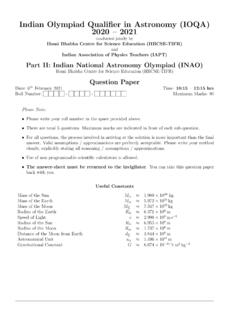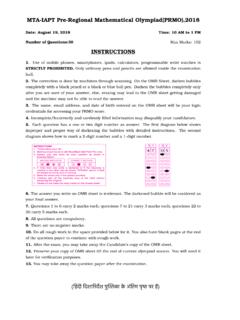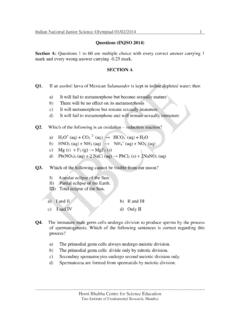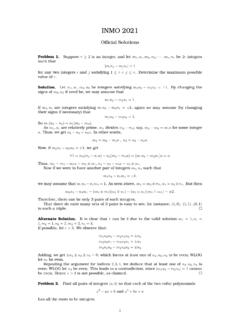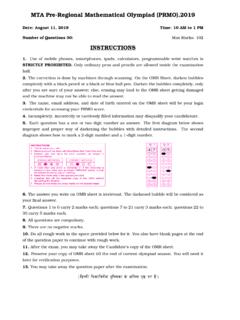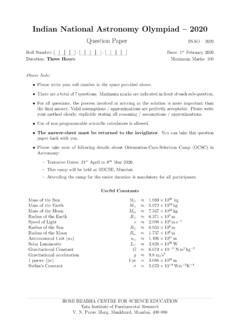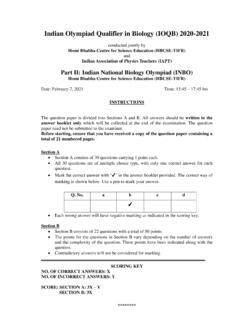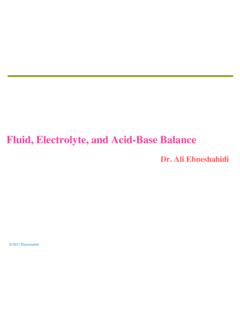Transcription of Indian Olympiad Qualifier in Chemistry (IOQC) 2020-2021
1 Indian Olympiad Qualifier in Chemistry (IOQC) 2020-2021 conducted jointly by Homi Bhabha Centre for Science Education (HBCSE-TIFR) and Indian Association of Physics Teachers (IAPT) Part II: Indian National Chemistry Olympiad (INChO) Homi Bhabha Centre for Science Education (HBCSE-TIFR) Date: February 6, 2021 Time: 15:45 17:45 hrs Roll No. Write your Roll No. at the space provided above. This question booklet consists of 14 printed sheets including periodic table. Check that the booklet has all the pages. If not, report to the invigilator immediately. You must show the main steps in the calculations and state the necessary assumptions wherever applicable. Answers written in pencil will be penalized. Use of non-programmable scientific calculator is allowed.
2 A copy of the Periodic Table of the Elements is provided at the end. Do not leave the examination room until you are directed to do so. The answer sheet must be returned to the invilator. You can carry this question paper with you. Fundamental Constants Avogadro number NA = 1023 mol 1 1 atm = 101325 Pa Molar gas constant R = J K 1 mol 1 Density of water = 1000 kg m 3 = L atm K 1 mol 1 1 Faraday = 96500 C pH = log [H+] pKa = log Ka Page 2 of 13 Problem 1 18 marks Persistent radical TEMPO Radicals are commonly known to be highly unstable due to their reactivity. However, in 1960, the synthesis and isolation of a stable radical, 2,2,6,6-tetramethylpiperidine-1-oxyl (TEMPO) changed this notion. Stable radicals are also called persistent radicals.
3 TEMPO, a persistent radical is a red solid compound which has applications in organic synthesis and chemical analysis. Part A: The redox equilibria of TEMPO Draw the resonance structure of TEMPO (including the lone pairs) other than the one shown above. The redox reactions of TEMPO are known to be affected by the pH of the medium. TEMPO undergoes one electron oxidation to yield species A. TEMPO also undergoes reduction (accompanied by protonation) to give B. E (A TEMPO) = V ( NHE) and E (TEMPO B) = V ( NHE). Draw the structures of A and B. Write the half-cell reaction and Nernst equation for the conversion of TEMPO to B (refer ). Derive the relation between the reduction potential (E) of TEMPO and pH. The stability of different redox species at specific potential and pH can be represented on a 2 dimensional plot as shown here for the TEMPO system.
4 Such a plot is known as Pourbaix diagram. In this diagram, the regions between the lines represent conditions at which one particular species is thermodynamically more stable than all other species. The lines represent equilibrium between two species (in this case at equal concentrations) under standard condition (T = K). A horizontal line (line 1) separates species related by electron transfer process only. The slant lines (line 2 and 3) separate species related by both electron and proton transfers. Draw the structure of C and write the equilibrium process between the species (with the structures) separated by line 4 at pH = Derive the expression for the ratio slope (line 3)slope (line 2) starting from the corresponding Nernst equations and determine its value using the parameters involved.
5 A disproportionation reaction is one in which two identical units of a species react together to give a reduced and an oxidized species. (Reverse of this reaction is called comproportionation reaction). At pH < 3, TEMPO undergoes disproportionation reaction, yielding A and C. TEMPOLine 1 Line 4 Page 3 of 13 Write balanced equation for the disproportionation reaction and determine the equilibrium constant for the reaction at standard temperature? Show the main steps of calculations. Part B: Using TEMPO in Electrochemical Oxidation In reaction mixtures, the electrochemical potentials can also be modified by non-reacting species (such as ions) present in the system. Also the typical conditions, such as [H+] may be very different from standard values of 1 M.
6 In such situations, a formal potential E is defined for the system as the potential of the system at equilibrium where certain species are at certain (typical) specified concentrations. For the following, net concentration of TEMPO species is taken as 1 mM, and pH as specified in each case. One of the important applications of A is to mediate the electrochemical oxidation of primary and secondary alcohols under mildly basic aqueous conditions. The products of the reaction include aldehydes/ketones in high yields and B, which is electrochemically converted back to A. A typical setup for this reaction involves i) a working electrode where the electrochemical regeneration of A takes place ii) a counter electrode for completion of the electrochemical circuit In addition, a reference electrode is used for ensuring the absolute potentials of working and counter electrodes in the cell.
7 Write the reaction taking place at the counter electrode and identify the anode and the cathode. Mechanistic studies reveal that the oxidation of alcohol (ROH) proceeds through a nucleophilic attack of the alkoxide ion on A. Draw the structure of the most favorable intermediate formed after the nucleophillic attack. After A is converted to B by alcohol, the species A is regenerated back from B in two steps: Step i) conversion of B to TEMPO. If done electrochemically, it requires a formal potential of at least E2 . Step ii) conversion of TEMPO to A. This requires a formal potential of at least E1 . For TEMPO in the above described cell, E1 doesn t change with pH, whereas E2 changes with pH as shown in graph here. If the working electrode is operated at potential E1 , a) write the balanced equations for the possible pathways by which B is converted to TEMPO under the following conditions: i) pH < 7 ii) pH > 7 Working Electrode Voltage Source Counter Electrode Reaction Mixture E (V) E E Page 4 of 13 b) Based on the above data, which of these conditions (i or ii) is expected to give higher conversion of alcohols to aldehydes/ketones per mol of A produced at the working electrode?
8 Introduction of functional groups to TEMPO can help in tuning its electrochemical properties. The effect of substituents on corresponding E1 values was studied for TEMPO analogs. Of the above three, write the analogs which are most likely to show pH-dependent E1 values in the pH range 2 to 7. Arrange the values of E1 for substituted TEMPO analogs at pH 7 in order. Graphs and diagrams are adapted from (Chem. Rev. 2018, 118, 4834 4885). Problem 2 14 marks Esters Many sweet-smelling compounds contain an ester functional group, R-CO-O-R , where R/R = alkyl, aryl groups. hydrolysis of an ester is an exhaustively studied reaction: RCOOR + H2O RCOOH + R OH The hydrolysis can be catalyzed by an acid (A) or a base (B).
9 The reaction may be unimolecular (1) or bimolecular (2), and may involve breaking of acyl-O bond (AC) or alkyl-O bond (AL). Thus, there are eight different mechanisms possible as listed in the table below. acid catalyzed Base catalyzed Unimolecular Bimolecular Unimolecular Bimolecular AAC1 AAC2 BAC1 BAC2 AAL1 AAL2 BAL1 BAL2 The mechanism in a given reaction depends on the structure of the ester and the reaction conditions. Consider the acidic hydrolysis of methylpentanoate in aqueous H2SO4. i) Draw the structure of the most favorable conjugate acid (D) of methyl petanoate. H+Methyl PentanoateD4-carboxy TEMPO4-amino TEMPO4-hydroxy TEMPO Page 5 of 13 ii) D is attacked by a water molecule (nucleophile) and, through a series of reactions, is broken into a carboxylic acid and an alcohol.
10 Identify the species E (a neutral molecule), F and G (both charged species). In the hydrolysis of K in moderately concentrated aq. H2SO4, the preferred mechanism involves conjugated acid (L) of K. L undergoes decomposition to form a stable product M and a cation N. N on reaction with water forms P. i) Draw the structures of L, M, N, and P. ii) Identify the slowest step in the reaction mechanism. iii) Using the Table in page 4, label the above reaction mechanism appropriately. An optically active sample of ester Q is completely hydrolyzed under aqueous acidic conditions. In the hydrolysis using moderately concentrated H2SO4, two additional compounds R and S (other than the expected alcohol and carboxylic acid ) having identical molecular formulae are formed in small amounts.

